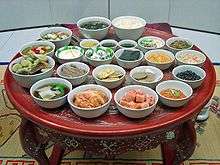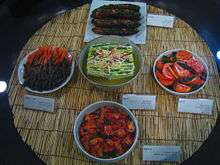Kimchi Field Museum
| Kimchi Field Museum | |
 Entrance to the museum | |
| Korean name | |
|---|---|
| Hangul | 김치박물관 |
| Hanja | 김치博物館 |
| Revised Romanization | Gimchi Bangmulgwan |
| McCune–Reischauer | Kimch'i Pangmulgwan |
 |
| This article is part of a series on |
| Korean cuisine 한국 요리 조선 료리 |
|---|
|
Staples |
|
|
The Kimchi Field Museum in Seoul, Korea is a museum whose mission is to inform the world about one of the major items of Korean cuisine, kimchi. Exhibitions focus exclusively on kimchi’s history, its varieties, and its importance to Korean culture and cuisine. It is open to anyone who is willing to learn about kimchi, the most famous Korean dish. The museum collects data for kimchi-related resources and statistics and also offers different activities, such as the kimchi-making process and kimchi-tasting each month.[1]
General information
- Established: 1986
- Location: 4~6th Floor of MUSEUM KIMCHIKAN, 35-4, Insa-dong gil, Jongno-Gu, Seoul
- Website: www.kimchikan.com
The museum is reopened at Insa-dong, Jongno-Gu, Seoul, Korea in April 21, 2015.
History
The Kimchi Field Museum was originally established in 1986 by Pulmuone Inc., one of the largest food production companies in Korea, in Pil-dong, Jung-gu. In 1988, the museum was moved to the COEX (Convention and Exhibition Center) to publicize kimchi among foreign visitors coming for the Summer Olympic Games held in Seoul, South Korea.[2]
In 2000, the museum was renovated to extend the museum area and improve its facilities for visitors in anticipation of the third Asia–Europe Meeting in Seoul, designed to deepen relationships in political, economic, and cultural areas among members of forty-one countries.
Exhibition

The museum is divided into three different sections. Each division of the museum illustrates varieties of kimchi-related information.
The first part of the museum is mostly related to kimchi’s history. In the first section, “The Exhibition of Ancient Books about Kimchi History,” visitors can see the old books and articles relevant to kimchi history. In “The Models of Kimchi in Each Period” visitors can inspect the trends of kimchi within the time periods of Korean history. The next section of the museum introduces stories of how people began to include hot peppers in kimchi. There is a detailed time line enabling visitors to easily view the history of kimchi.
The second branch of the Kimchi Field Museum consists of sections that display the process of kimchi making, as well as short films which play at regular intervals. There is a section where people can view models of eighty different kinds of kimchi. On the walls are graphic illustrations, including kimchi recipes, with a picture and description for each item. In addition there is information about what kind of spices people have used before they adopted red peppers from Japan and Korea. Another section illustrates the kinds of kimchi by geographic district.
Moreover, the museum provides detailed explanations of the process of making kimchi with a diorama for each step. There is also one section where people can view the typical environment (background) that people used to have on the day of making kimchi, including the historic pottery forms utilized for the fermentation and storage processes.
There are two photo zones where people can take pictures of kimchi. Also, in a particular section, people can read about the nutritional benefits of kimchi and compare it with other kinds of fermented vegetables in the world. Guests are also welcome to visit an area where they can observe the Lactobacillus bacteria in kimchi through a microscope. Furthermore, the museum also displays a large world map with countries to which kimchi is exported. A tasting room is open for people to test two different kinds of kimchi in each month.
The final section of the museum consists of a data room where people can read old or recent books about not only kimchi, but also about the traditional foods of Korea. There are also kimchi-related articles and movies that are available in the data room.
References
- ↑ Kang, Michelle (25 May 2012). "Kimchi, liquor on display at unique museums". Joongang Daily. Retrieved 6 October 2012.
- ↑ Kimchi Field Museum, English intro.
See also
| Wikimedia Commons has media related to Kimchi Field Museum. |
Coordinates: 37°30′45″N 127°03′32″E / 37.5125°N 127.0588°E